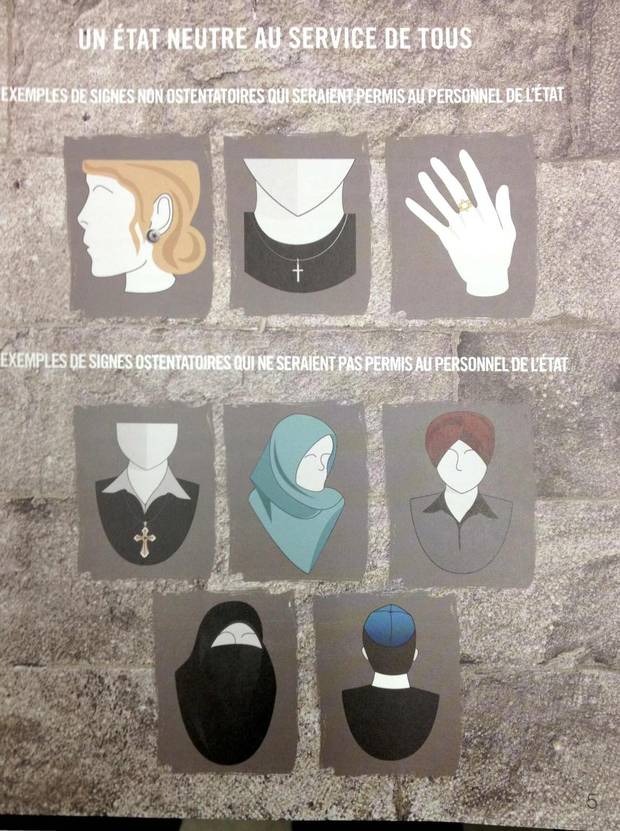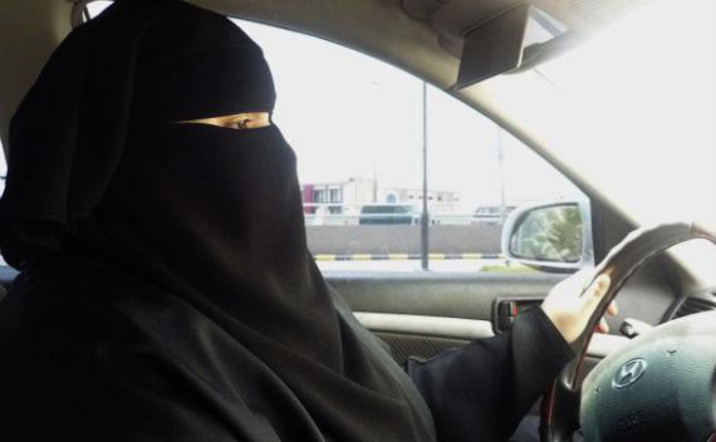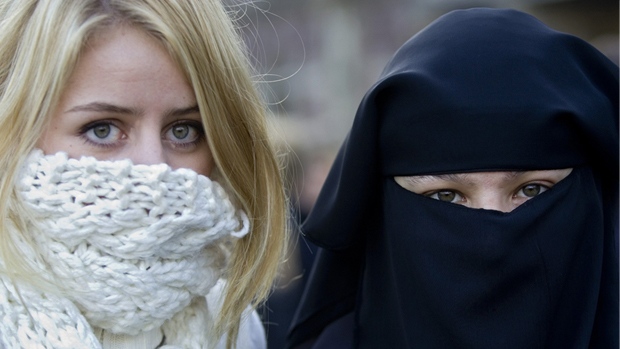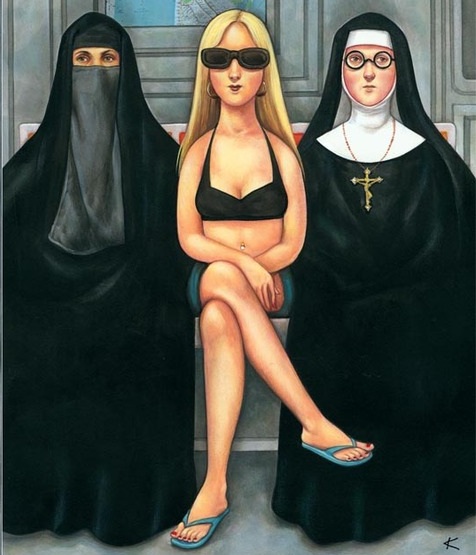The Power of Symbols
UPDATE MARCH 12, 2017 (Web Photo):
The recent decision (March 2017) by a senior court in the European Union to allow the banning of any religious headgear by a businesses keeps alive the myth that some types of religious headgear are more dangerous than others.
While many kinds of head coverings are popular, particularly in cold weather Canada, some coverings, the Niqab and Burqa as two examples, often evoke a strong negative reaction in Western nations. It is not the headdress; it is the context and symbolism that brings the response to those who have not taken the time to delve into the issue.
In the photo above it is clear the woman on the left is voluntarily wearing the covering as a response to the weather. For the woman of the left, however, the covering is not only tied to religion but also to the power men hold over women. And, in the case of the Niqab and Burqa, that debate is not likely to end anytime soon.
Do similar debates take place in countries defined as Muslim. Check out a few of the astounding discoveries made while Lynn McNeill, Esther and Garth Dunn and I were traveling through the Middle East during November and December 2013.
Is it reasonable to place limitations on the wearing of religious apparel?
When traveling, if we keep our minds open, it’s easy to find the world may be defined in a manner different than that which we have been lead to believe. While a large portion of our worldview results from our prejudice, our negative views and fears are certainly enhanced by the actions of TV and print media, politicians, social media and, of course, religious groups themselves. Our family and friends also play a huge role in our evolving positive or negative views of others.
Let’s jump to an ongoing controversy that became the turning point in the recent (2013) Quebec Election – the wearing or  displaying of religious symbols by public servants. In 2017 it remains an issue being played out in the European Courts and pending European elections, as well as in Canada with the current Conservative Party leadership race being an example of how things can go negative if that may help a candidate to win a few more votes.
displaying of religious symbols by public servants. In 2017 it remains an issue being played out in the European Courts and pending European elections, as well as in Canada with the current Conservative Party leadership race being an example of how things can go negative if that may help a candidate to win a few more votes.
Graphic (Web Source): This chart was circulated by the PQ when they rolled out proposed changes to the Quebec Charter. The top three items would be approved. The bottom five would not. It was not long before the Niqab (the partial face covering bottom left) became the central issue. It is easy to see a between the application to different religious belief systems. So the question, if what we wear does not interfere with what we do (within bounds), does it make any difference what we wear?
While the Quebec Charter amendment crossed the line on many points, it was the Niqab and Burqa that quickly rose to the top of the debate. This was primarily because those particular head coverings suggest the oppression of woman, something that is an anathema to basic freedoms in Canada. Mind you, over that past 150 years of our nation, we managed to accomplish the suppression fairly well without even referring to the Muslim headdress.
Never-the-less, our Charter of Rights and Freedoms, a relatively new document that came into being in 1982, provided our citizens with the right to practice their religion (within reasonable limits) as they see fit. It now seem’s some would prefer to limit those rights even though it conflicts with the Charter and may infringe up the rights of some women in particular. Clearly, not every country has a Charter of Rights, therefore, in those countries, and this includes within a great many religions, the equality of women is not always given the high priority it is in Canada.
It is easy to understand why this particular issue arises in Canada, as our country is made up of people from all around the world and of every religious persuasion. Never-the-less, we do amazingly well if we consider all the possible friction points that exist.
Now let’s skip back to the Middle East – Oman and Saudi Arabia in particular. In those countries, it is not hard to find women wearing full or partial face coverings (yet they are not ubiquitous). The question, do any restrictions exist? First, look at Oman, a country ruled by a Sultan. In Oman, about half the employment is provided by the Sultanate, employment similar to our public service (e.g.teachers, government workers, hospitals, ambulance and so on).
While women have many freedoms in Oman, it is still a Muslim country where the religion of the state is Islam and Islamic Shariah the basis of all legislated laws. To some extent, this suggests freedom does not reach a level that exists in Canada where State power is limited by the Charter of Rights and Freedom. In Canada, our Charter includes freedom to practice the religion of our choice, including the freedom of wearing religious symbols.
Across Oman, a certain level of modesty is expected of all women and, to a lesser extent, men when appearing in public or when entering a  mosque. Tourists are expected to dress modestly particularly in religious venues. Other than that, the country is a ‘westernized’ and welcoming place for tourists.
mosque. Tourists are expected to dress modestly particularly in religious venues. Other than that, the country is a ‘westernized’ and welcoming place for tourists.
Now, for the mind blower – in Oman, female government employees cannot wear a Niqab or Burqa while at work. Neither can the headdress be worn in instances where it either restricts vision (safety issue) or where identification is an issue. Jump behind the wheel of a motor vehicle (photo left), and the facial part of the headdress must be removed (turning it into a Hijab). In the centre middle line in above chart is the more popular form of head covering in the Middle East and, for that matter, most parts of the world.
Wear the full covering while driving in Oman (as is the woman in this photo) and the next stop could be by a Royal Oman Traffic Cop with his ticket book in hand. There is even a traffic standardization effort underway to have this rule applied across all the Gulf States (Link to Proposed Driving Ban). Of course, such a ban in Saudi Arabia would be a moot point as women are not allowed to drive. That is likely a more important issue for women than a face covering.
Let’s now travel 2000 kilometres west to Mecca, in Saudi Arabia, the holiest place in the Muslim world. In Mecca strict rules govern a pilgrimage, with one rule being – a woman cannot cover her face even if they do so in their country of origin. (HAJJ clothing for women). They are allowed to cover their face with their hand while in the presence of a foreigner, but that’s about it.
My bet is that the majority of Canadians, or for that matter most people in the Western world, have no idea that such rules exist in the Muslim world. How is it, in all the heated debates that take place about the Burqa and Niqab, this little detail has never made the front page or cited in a debate. Perhaps it has, but in an extensive online search, I found no such reference in any Press Release, T.V. report or government document. It took a trip to the Middle East to discover that tidbit.
While I may be missing something, it seems to me this is relevant to the discussion. Please take the time to scan through the links below and the attached photos. You might find the discussion to have more depth than at first blush.
The clothing worn by each of these women speaks volumes about their lives and, perhaps, about their freedom to choose. Does the religious apparel of the two on the side suggest one is more oppressed than the other? How about the woman in the middle? Has that woman been influenced by advertising? I urge you not to rush to judgment on any of the three…
For a humorous discussion on this subject: Link Here
Other Links
Link Here to the Facebook Photo Album: The Clothing Symbols of Cultures and Occupations
For a discussion of how bigotry and racism plays a role read this post on the Twenty-First Chromosome
Catholic Nuns in the United States face Vatican Rebuke: You Tube Post
Women in Vatican: An Ecclesiastical Ceiling Link Here
Photos from Salala, Oman: Link Here
Photos from Muscat, Oman: Link Here
(1737)
Trackback from your site.


